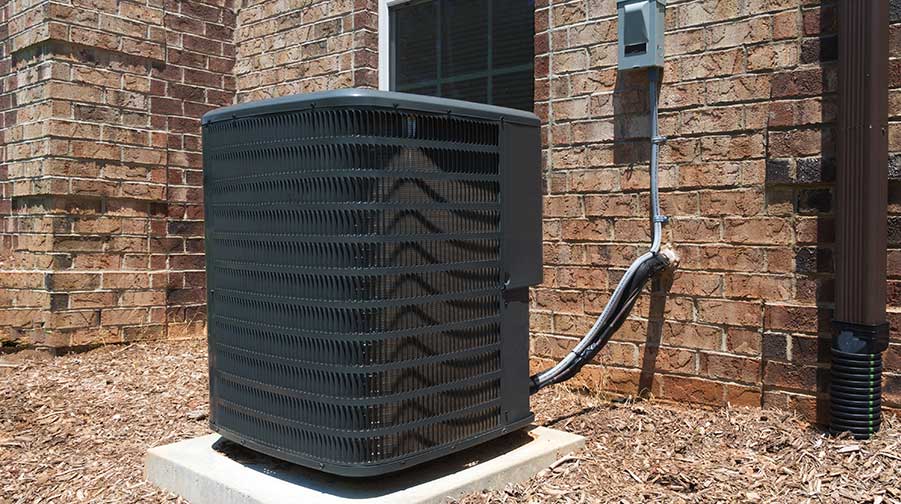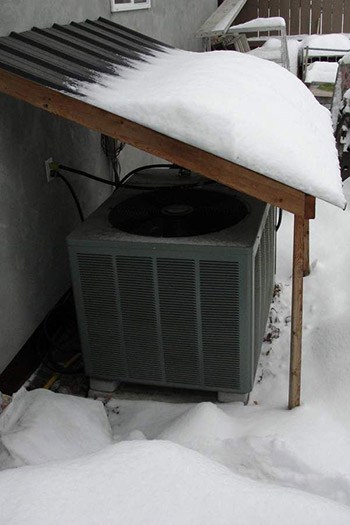
Are you looking to hide or enclose your exterior heat pump? Maybe you are looking to protect your heat pump from snow or ice. Perhaps you don’t like the system’s positioning, and you don’t want to look at it. Whatever your reasoning, if you are going to enclose your heat pump, there are some details you need to be aware of.
First, let’s answer your question. Can you enclose a heat pump?
You can hide a heat pump provided you maintain proper clearances around the unit for adequate airflow. External heat pump systems need an average of 18- to 24-inches (up to 2 feet) around their sides at all times. Your heat pump system draws outside air across the exterior condenser coil and expels it out the top of the unit during operation.
If you are concerned about security or protecting the system from environmental elements, you have options to protect your system and not obstruct the airflow around the heat pump.
While it is important to note that your heat pump needs a lot of space, you may have many questions surrounding heat pump enclosures’ exact dos and don’ts. Below I will walk you through these and how to protect your unit while keeping its processes safe and efficient.
Heat Pump Clearance Requirements
Heat pumps need a wide berth to run at max efficiency and remain safe. To pump enough air per minute for the device to do its job, it needs to have sides and a top that does not infringe upon its needs. Many items can cause issues with blocking clearance, such as bushes and shrubs, leaves, walls, and fences. It is essential to examine the physical space surrounding your heat pump and clear it of any object blocking its clearance.
In general, you want to keep the sides of the unit 18- to 24-inches from any possible obstructions. When installed, it should naturally be 24-inches from the wall of the building. The top of the unit should be clear without anything placed above it.
If you are planting anything or putting a fence around your heat pump, make sure to follow these distance guidelines and keep the top completely clear. If this is not done, the heat pump will be working overtime to process enough air to pump into the home. This will result in the heat pump seeing a reduction in both energy savings and life expectancy.
Considering that your heat pump works by sucking in external air, heating it, and then pumping it into your home, any obstruction will reduce its ability to function correctly. Obstructing the clearance of your heat pump is like placing a bag or blanket over your face and then expecting to be able to breathe the same amount of air in it is not efficient, requires much more energy, and reduces your life expectancy.
If you are having issues with your heat pump not producing enough heat, you could have a clearance issue where the air is restricted around the heat pump. In our article, 16 Reasons Your Heat Pump Doesn’t Blow Hot Air, and we discuss 16 reasons why your heat pump is not producing heat.
Why You Can’t Cover the Heat Pump Condenser in Winter
Heat pumps and covering them can be shrouded in a crowd of mystery (or, in many cases, ignorance). While you may see a neighbor put a cover on their heat pump, this does more damage than it does good. There are a couple of reasons for this.
It would be best not to cover your heat pump condenser during winter (or any other season). The main reason is that it can run year-round, so protecting it would cause the unit to go into overdrive trying to get air or even break. Even if it does not run year-round, covering your unit can trap moisture inside. The cover may also make a welcome home for small animals.
As you can see, covering your heat pump condenser during the winter months can cause you more harm than good. It is unwise to do this, even if the unit will not be running. It is best if you are worried about snow and ice that you only remove the build-up around the unit and allow its defrost mode to do the rest.
When thinking about heat pump condensers, consider that the manufacturer was sure to create this design with these problems in mind. It is likely that the device’s designer also uses the same one, so they would be sure to design an efficient model. That said, it is best to trust that you built the device to keep frost off and function best without obstructions. By interfering with the device’s standard processes, you limit its capacity to work as it was designed.
Inspectors Note: These suggestions only apply to heat pumps. If you have an air conditioning unit and a gas furnace, you can cover your air conditioner in the winter when it is not in use or winterize it at a vacation home that you do not plan to use during the winter months.
How to Protect Your Heat Pump Condenser in the Winter
First, recognize what you already built your unit to handle. These are meant to be outdoor units that are accustomed to varying weather and seasonal changes. Most heat pump condensers can take a decent amount of ice and snow build-up and have a defrosting capability built-in as well as emergency heat.
If you are freezing or you expect to go through a harsh winter, there are a few steps that you can take to help prevent any issues with your heat pump condenser.
- Remove any debris around the unit regularly.
This is going to be the first and easiest step for manual involvement. Make sure that all snow and ice are clear from the crevices around the condenser. The most challenging place to reach is likely between the condenser and the wall. This will be an attractive place for both leaves and snow, so it should be swept clean regularly and in all seasons. The more frequently you complete this process, the less build-up you are likely to find.
- Use warm or cool (not hot) water to remove large amounts of ice.
Always use a hose or warm water. You never want to toss hot water on a piece of machinery in the winter, but if you get lukewarm or warm water, you can melt the ice stuck on the condenser. Remember, it is accustomed to rain and designed to withstand it, not harm the device.
- Build a canopy high over the unit.
Keeping in mind that you should not cover the unit and that the device should have a clearance of 18- to 24-inches, you can create a small roof high above it to prevent snow build-up. If this is how you want to go about it, read the next couple of sections for ideas and plans for how to do this efficiently. This may help to provide the confidence you need to avoid covering it inappropriately as many are tempted to.
- Never scrape the sides with anything.
The sides of a heat pump are easily damaged and intake the air that comes in. Scraping these could cause more harm than good. Therefore, it is best to scrape around the heat pump and then use the defrost setting to melt anything left.
- Call a professional.
If you are ever in doubt, call someone who knows what they are doing. Any trained HVAC worker will test, clean, and reset your unit to make sure it is working correctly. It is much better to use a safe and secure approach to such an essential component of your home’s heat system than to mess it up by attempting to resolve an issue on your own.
Heat Pump Fan Covers
You may be looking to cover your heat pump to avoid snow falling directly onto it or prevent rainfall directly into the unit. Several workarounds for this can be cost-effective. While we do not recommend doing something that will cover your pump completely, as long as you leave adequate clearance for it to breathe, there should not be any issues. Again, remember an 18- to 24-inch clearance rule of thumb for any of these ideas.
For an affordable (and non-obtrusive) option, it can be easy to install a Kool Kap Condensing Unit Protective Cover over-the-top fan. The Kool Kap cover is hinged to open when in use and will close over the fan when not in use and open when needed by the force of the fan. Kool Kap covers are a simple do-it-yourself project.
It’s essential to be sure your heat pump is level for the Kool Kap to work correctly. For information on keeping your heat pump level, see our article Should Heat Pumps and Air Conditioners Be Level?
Enclosures to Hide Your Heat Pump
If you are looking for a simple structure to hide the unit, you can accomplish this with wood or vinyl privacy fencing. You can also purchase pre-built screened enclosures.
If you are handy with tools and like do-it-yourself projects, the video below outlines how to build a simple enclosure with products from your local building supply store.
If you want a more durable and permanent solution, you can have a licensed contractor construct a heat pump shelter like the one pictured here. Be mindful that the contractor allows for proper clearances and access for repair or service.
These structures can be made to be hinged open or completely removable.
Heat Pump Snow Shelter Plans

Since heat pumps can work in subfreezing temperatures, a heat pump shelter can be good year-round if it is well built. Or you can create something simple that can be put up and taken down relatively easily. It is crucial that this shelter is sturdy and protects the entire area surrounding the condenser so you aren’t still shoveling snow from behind it.
One of the simplest ways is to build a small overhanging roof. This can be done with plywood and pine and then painted to match your home. Once you have the roof, hang it at an angle using a couple of support beams (2×4 or 4×4’s) to hole the front of it.
This will leave plenty of open-air around your unit but will also cover the entire area around the condenser – meaning no mess to clean. Here is a simple post about how to do this.







